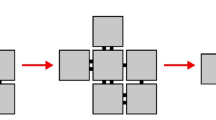Abstract
In this paper, we investigate the power of systems in the abstract Tile Assembly Model to self-assemble shapes having fractal dimensions between 1 and 2. We introduce a concept of sparsity as a tool for investigating such systems and demonstrate its utility by proving how it relates to fractal dimension.
M. J. Patitz—This work was supported in part by National Science Foundation grant CAREER-1553166.
Access this chapter
Tax calculation will be finalised at checkout
Purchases are for personal use only
Similar content being viewed by others
Notes
- 1.
Here a standard counter gadget refers to commonly used log-width counter gadgets. It is unknown whether or not counter-like gadgets can be implemented in a sparse way.
- 2.
There are universal Turing machines which induce asymptotically smaller runtime blowups, but choosing one with a quadratic blow up makes analysis of the final fractal dimension easier.
References
Barth, K., Furcy, D., Summers, S.M., Totzke, P.: Scaled tree fractals do not strictly self-assemble. In: Ibarra, O.H., Kari, L., Kopecki, S. (eds.) UCNC 2014. LNCS, vol. 8553, pp. 27–39. Springer, Cham (2014). https://doi.org/10.1007/978-3-319-08123-6_3
Cannon, S., et al.: Two hands are better than one (up to constant factors): self-assembly in the 2HAM vs. aTAM. In: Portier, N., Wilke, T. (eds.) STACS, volume 20 of LIPIcs, pp. 172–184. Schloss Dagstuhl - Leibniz-Zentrum fuer Informatik (2013)
Chalk, C.T., Fernandez, D.A., Huerta, A., Maldonado, M.A., Schweller, R.T., Sweet, L.: Strict self-assembly of fractals using multiple hands. Algorithmica 76(1), 1–30 (2015). https://doi.org/10.1007/s00453-015-0022-x
Demaine, E.D., Patitz, M.J., Rogers, T.A., Schweller, R.T., Summers, S.M., Woods, D.: The two-handed tile assembly model is not intrinsically universal. In: Fomin, F.V., Freivalds, R., Kwiatkowska, M., Peleg, D. (eds.) ICALP 2013. LNCS, vol. 7965, pp. 400–412. Springer, Heidelberg (2013). https://doi.org/10.1007/978-3-642-39206-1_34
Doty, D., Gu, X., Lutz, J.H., Mayordomo, E., Moser, P.: Zeta-Dimension. In: Jȩdrzejowicz, J., Szepietowski, A. (eds.) MFCS 2005. LNCS, vol. 3618, pp. 283–294. Springer, Heidelberg (2005). https://doi.org/10.1007/11549345_25
Doty, D., Lutz, J.H., Patitz, M.J., Schweller, R.T., Summers, S.M., Woods, D.: The tile assembly model is intrinsically universal. In: Proceedings of the 53rd Annual IEEE Symposium on Foundations of Computer Science. FOCS 2012, pp. 302–310 (2012)
Evans, C.G.: Crystals that count! Physical principles and experimental investigations of DNA tile self-assembly. Ph.D. thesis, California Institute of Technology (2014)
Furcy, D., Summers, S.M.: Scaled pier fractals do not strictly self-assemble. Nat. Comput. 16(2), 317–338 (2015). https://doi.org/10.1007/s11047-015-9528-z
Hartmanis, J., Stearns, R.E.: On the computational complexity of algorithms. Trans. Am. Math. Soc. 117, 285–306 (1965)
Hendricks, J., Opseth, J., Patitz, M.J., Summers, S.M.: Hierarchical growth is necessary and (sometimes) sufficient to self-assemble discrete self-similar fractals. In: Doty, D., Dietz, H. (eds.) DNA 2018. LNCS, vol. 11145, pp. 87–104. Springer, Cham (2018). https://doi.org/10.1007/978-3-030-00030-1_6
Hendricks, J., Olsen, M., Patitz, M.J., Rogers, T.A., Thomas, H.: Hierarchical self-assembly of fractals with signal-passing tiles (extended abstract). In: Rondelez, Y., Woods, D. (eds.) DNA 2016. LNCS, vol. 9818, pp. 82–97. Springer, Cham (2016). https://doi.org/10.1007/978-3-319-43994-5_6
Hendricks, J., Opseth, J.: Self-assembly of 4-sided fractals in the two-handed tile assembly model. In: Patitz, M.J., Stannett, M. (eds.) UCNC 2017. LNCS, vol. 10240, pp. 113–128. Springer, Cham (2017). https://doi.org/10.1007/978-3-319-58187-3_9
Hendricks, J., Patitz, M.J., Rogers, T.A.: Universal simulation of directed systems in the abstract tile assembly model requires undirectedness. In: Proceedings of the 57th Annual IEEE Symposium on Foundations of Computer Science (FOCS 2016), New Brunswick, New Jersey, USA 9–11 October 2016, pp. 800–809 (2016)
Kautz, S.M., Lathrop, J.I.: Self-assembly of the discrete Sierpinski carpet and related fractals. In: Deaton, R., Suyama, A. (eds.) DNA 2009. LNCS, vol. 5877, pp. 78–87. Springer, Heidelberg (2009). https://doi.org/10.1007/978-3-642-10604-0_8
Kautz, S.M., Shutters, B.: Self-assembling rulers for approximating generalized Sierpinski carpets. Algorithmica 67(2), 207–233 (2013)
Lathrop, J.I., Lutz, J.H., Patitz, M.J., Summers, S.M.: Computability and complexity in self-assembly. Theory Comput. Syst. 48(3), 617–647 (2011)
Lathrop, J.I., Lutz, J.H., Summers, S.M.: Strict self-assembly of discrete Sierpinski triangles. Theoret. Comput. Sci. 410, 384–405 (2009)
Lutz, J.H., Shutters, B.: Approximate self-assembly of the Sierpinski triangle. Theory Comput. Syst. 51(3), 372–400 (2012)
Padilla, J.E., Patitz, M.J., Schweller, R.T., Seeman, N.C., Summers, S.M., Zhong, X.: Asynchronous signal passing for tile self-assembly: fuel efficient computation and efficient assembly of shapes. Int. J. Found. Comput. Sci. 25(4), 459–488 (2014)
Patitz, M.J., Summers, S.M.: Self-assembly of discrete self-similar fractals. Nat. Comput. 1, 135–172 (2010)
Patitz, M.J., Summers, S.M.: Self-assembly of decidable sets. Nat. Comput. 10(2), 853–877 (2011)
Patitz, M.J., Summers, S.M.: Self-assembly of infinite structures: a survey. Theor. Comput. Sci. 412(1-2), 159–165 (2011). https://doi.org/10.1016/j.tcs.2010.08.015
Rothemund, P.W.K., Papadakis, N., Winfree, E.: Algorithmic self-assembly of DNA Sierpinski triangles. PLoS Biol. 2(12), e424 (2004)
Rothemund, P.W.K., Winfree, E.: The program-size complexity of self-assembled squares (extended abstract). In: STOC 2000: Proceedings of the Thirty-second Annual ACM Symposium on Theory of Computing, pp. 459–468, Portland, Oregon, United States. ACM (2000)
Soloveichik, D., Winfree, E.: Complexity of self-assembled shapes. SIAM J. Comput. 36(6), 1544–1569 (2007)
Winfree, E.: Algorithmic Self-Assembly of DNA. Ph.D. thesis, California Institute of Technology, June 1998
Woods, D., et al.: Diverse and robust molecular algorithms using reprogrammable DNA self-assembly. Nature 567, 366–372 (2019)
Acknowledgments
The authors would like to thank the three anonymous reviewers whose comments helped improve the presentation and technical correctness of this paper.
Author information
Authors and Affiliations
Corresponding author
Editor information
Editors and Affiliations
Rights and permissions
Copyright information
© 2021 Springer Nature Switzerland AG
About this paper
Cite this paper
Hader, D., Patitz, M.J., Summers, S.M. (2021). Fractal Dimension of Assemblies in the Abstract Tile Assembly Model. In: Kostitsyna, I., Orponen, P. (eds) Unconventional Computation and Natural Computation. UCNC 2021. Lecture Notes in Computer Science(), vol 12984. Springer, Cham. https://doi.org/10.1007/978-3-030-87993-8_8
Download citation
DOI: https://doi.org/10.1007/978-3-030-87993-8_8
Published:
Publisher Name: Springer, Cham
Print ISBN: 978-3-030-87992-1
Online ISBN: 978-3-030-87993-8
eBook Packages: Computer ScienceComputer Science (R0)




